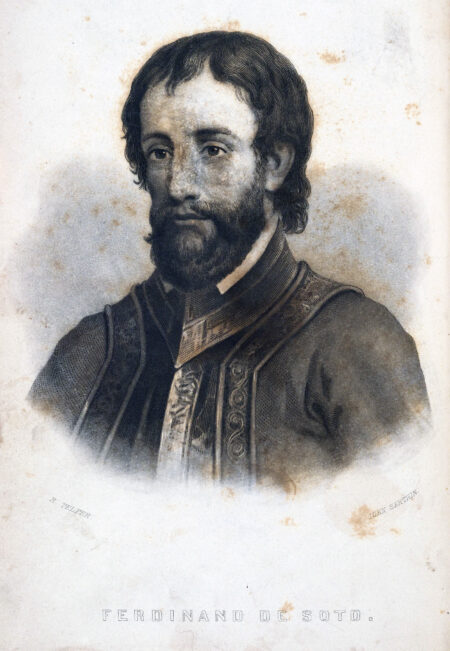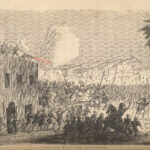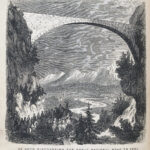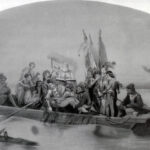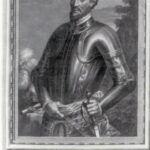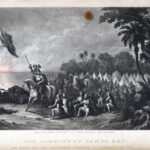Hernando de Soto
Explorer
Age of Discovery
Quick Facts:
Spanish explorer and conquistador who helped conquer parts of Central and South America, explored the southeastern region of the United States, and is credited as the first European to cross the Mississippi River
Introduction
Hernando de Soto is more known for being a conquistador. He helped conquer many lands in parts of Central and South America, including those of the Inca Empire. But he was also an explorer. De Soto explored and mapped parts of nine states in the southeastern part of the United States. His explorations took him from present day Florida up to North Carolina, and west of the Mississippi River. History recognizes his great achievement of being first recorded European to discover and cross the Mississippi River.
Biography
Early Life
Hernando de Soto’s exact date of birth is unknown. He was born sometime between 1496 and 1501 in Jerez de los Caballeros, Spain. This was a small town in the Estremadura region. His parents were Francisco Mendez de Soto and Leonor Arias Tinoco. They were thought to have been of minor nobility, meaning they were neither rich nor poor.1 Hernando had an older brother named Juan, and two younger sisters: Catalina and Maria. Young Hernando would have received a standard education that included subjects like math and history. His parents hoped he would become a priest or lawyer, but de Soto had more interest in adventure.2 Hernando would need to learn a trade because his brother Juan, being the eldest son, would inherit their parent’s land and money when the died. Hernando would get nothing. In 1514, Hernando was sent by his father to the port city of Seville, Spain. Here, young de Soto began working for a man named Pedro Árias Dávila (he was also known as Pedrarias Dávila). Under Dávila, Hernando de Soto would get his first opportunity to sail to distant places for adventure. In 1514, de Soto joined Dávila’s expedition to the New World.
Also on this journey was another man who would become famous for his explorations of the Southwest United States – Francisco Vásquez de Coronado.3 Dávila had been appointed the new governor of Darién, Panama in what would become Central America. This land had been previously conquered by the conquistador Vasco Nuñez Balboa. Dávila’s crew set sail April 11, 1514 with a fleet of 20 ships and about 200 people.4 They crossed the Atlantic Ocean and landed in the rainforests of Central America. It took about two months to get there. These areas were already inhabited by native people who had previously encountered Spaniards. These encounters usually resulted in the Spanish soldiers enslaving and killing the natives, so the native people feared them. Hernando de Soto would also partake in deadly invasions. Hernando led many raids against the indigenous people, and his reputation as a brave soldier grew. He became a captain by 1520. As Dávila’s representative, de Soto was allowed to explore Central America in search of treasure and land. Among the areas he explored in the 1520s were modern day Costa Rica and Honduras. De Soto conquered Nicaragua in 1524, and was soon was made the alcade – or mayor – in León. But de Soto was not satisfied for long. He still wanted more adventure. This opportunity came was he learned that Francisco Pizarro was planning an exploration of the northwestern Pacific coast of South America.5
Voyages
Principal Voyage
In 1530, Hernando de Soto signed on with Pizarro’s expedition to explore more of Central and South America. De Soto departed Nicaragua in 1531 and soon joined joined Francisco Pizarro in Peru. At this time, the land was inhabited by the Inca Empire. Over the next several years, de Soto would play a heavy role in the conquering of the Inca civilization. Not only did the Spaniards have superior weapons, but plagues and diseases infected the Inca, causing their army numbers to fall. They captured Atahualpa, chief of the Incas, and Pizarro picked de Soto as his representative to the Inca ruler. Atahualpa had great wealth, so to gain his freedom he gave de Soto and the Spaniards much silver and gold. But Pizarro executed him anyway, and they kept the riches for themselves. De Soto received the third largest portion of wealth, after Francisco Pizarro and his brother Hernando.6 After this, de Soto marched onto and conquered the Inca capital city of Cuzco. He was the first European to enter this city.7 He captured the city, and claimed many of the riches for himself. Now a very wealthy man de Soto sailed from Peru in 1535, reaching Spain once more in 1536.
During his time in Spain, he married Isabel de Bobilla, daughter of Pedrarias Dávila. Despite having a new wife and a home in Spain, de Soto grew restless. He wanted to be a governor like Pizarro. He petitioned Emperor Carlos V for lands in either Ecuador, Guatemala, or Colombia. All three requests were denied. But the crown soon granted him the right to go and conquer and govern the territory La Florida. This area would eventually become the state of Florida we know today. For the next few years, de Soto and his men would go on to explore what would become the southeastern United States. De Soto departed Spain on his flagship San Cristóbal in April 1538. He took with him about 600 men, and numerous horses, dogs, and pigs. De Soto had been granted governorship of Havana, Cuba. They stopped there to take control of the colony. The expedition sailed for La Florida May 18, 1539 and landed near modern day Tampa Bay on May 25.8 The began moving north, and then northwest. They stopped at the Apalachee town of Anhaica – near present day Tallahassee – in early fall. They stayed here through winter. It would be several months before de Soto’s expedition would continue onward.
Subsequent Voyages
They began their journey of exploration once more in spring 1540. When de Soto and his team set off again, they moved more north east towards present day Georgia. After this came what would become the Carolinas. They soon crossed the Appalachian Mountains into present day Tennessee and traced the Tennessee River Valley. Finding no gold, they turned south, heading into present day Alabama. They arrived at a town called Mobila (near present day Mobile) where they fought with the natives who lived there.9 Afterwards, they turned northwest out of Alabama and into present day Mississippi. Here another battle took place in which the Spaniards fought off the natives. Soon after, they made camp, and spent the winter in Mississippi. They continued on several months after, and in May 1541, de Soto and his men came upon the Mississippi River. They built rafts and crossed the river. Hernando de Soto and his expedition became the first Europeans to see and cross the mighty Mississippi River.
Later Years and Death
After the crossing, the expedition headed into modern day Arkansas. They would spend the next year in Arkansas looking for gold and other mineral riches. Finding none, they soon returned across the Mississippi River. It was not long after the return crossing the de Soto was struck with a fever and fell deathly ill. He never recovered. Hernando de Soto died May 21, 1542.10 His crew continued on without their fearless leader, eventually reaching a Spanish settlement in New Spain (present day Mexico).11
Legacy
Hernando de Soto’s expedition was one of the most elaborate efforts made by the Spanish to explore the interior of North America. De Soto’s and his men were the first to thoroughly explore most of the southern half of the modern United States. He is credited as being the first European to discover and cross the great Mississippi River. It is important to note the unfortunate negative impact made by the Spanish explorer. The indigenous peoples encountered by de Soto and his men were exposed to European diseases such as measles, smallpox and chickenpox, for which they had no immunity, causing massive loss of life amongst the Native Americans. Nevertheless, de Soto’s records and maps not only greatly added to Europe’s knowledge of the New World but also provided information on the practices and culture of Native Americans prior to the arrival of Europeans.
EndnotesImages

